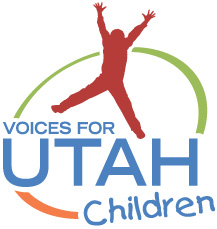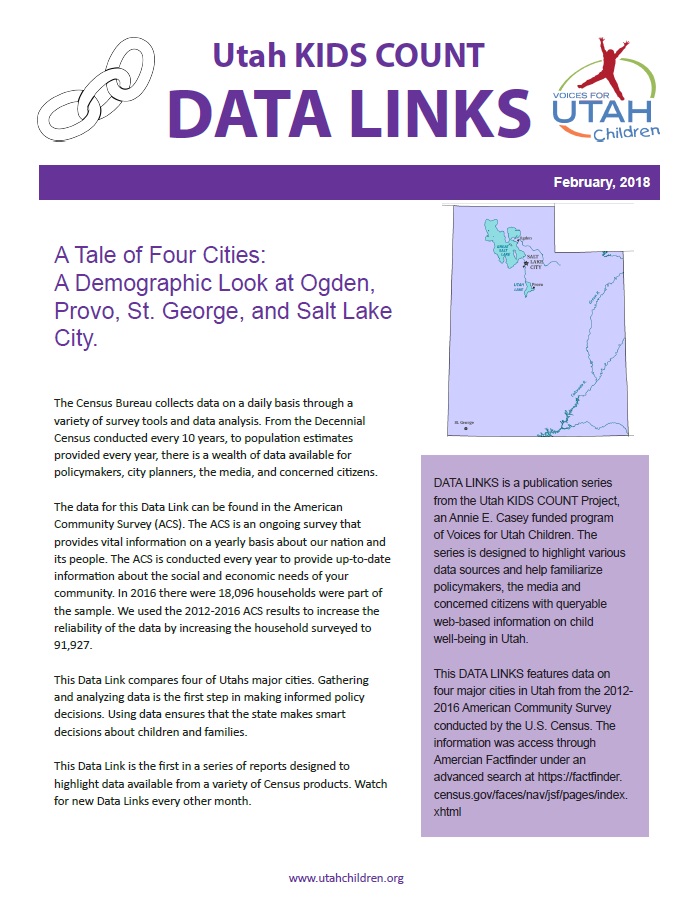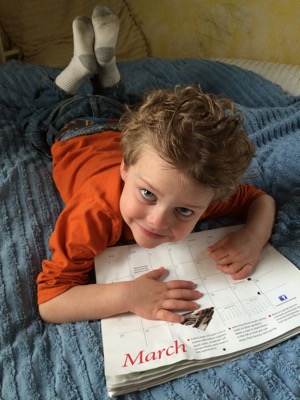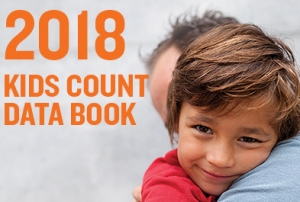Kids Count

Released: Wednesday, June 27 at 12:01 a.m. ET
Contact: Terry Haven 801-554-6570
Utah Ranks Sixth Nationwide in Child Well-Being
Data shows the state struggles in the area of health where the child death rate continues to worsen.
Salt Lake City — Utah ranks sixth when it comes to overall child well-being according to the 2018 KIDS COUNT Data Book, released today by the Annie E. Casey Foundation. The state saw improvement in the majority of the 16 indicators included in the publication. Yet, despite positive trends across three out of four of the domains, advocates at Voices for Utah Children are concerned about the health domain where two out of the four indicators worsened.
Utah saw a 3 percent increase in the percent of low birthweight babies that dropped the state from 12th in 2010 to 15th in 2016. Similarly, the state saw an 8 percent rise in the child and teen death rate between 2010 and 2016, ranking Utah 20th. The percentage of children without health insurance, while improving along with the rest of the nation, was our lowest ranking at 40th in 2016.
“Utah has made progress improving our child insurance rate thanks to CHIP, Medicaid and the Affordable Care Act, but we are still lagging behind the rest of the nation. We need to follow the lead of high-performing states by expanding Medicaid, helping kids stay covered year-round by improving Medicaid eligibility and outreach, and ensuring that immigration status is not a barrier to kids’ coverage,” says Jessie Mandel, Senior Health Policy Analyst for Voices for Utah Children.
Part of the rise in child and teen death rates can be attributed to a rising suicide rate among teens. Voices for Utah Children sees a need for more school-based services. “The critical shortage of school nurses and counselors highlights the need for more school-based healthcare services. Kids need a place to go for care and support before a condition or a problem escalates,” says Mandel.
The annual KIDS COUNT Data Book uses 16 indicators to rank each state across four domains — health, education, economic well-being and family and community — as an assessment of child well-being. Utah ranks:
- 7th in economic well-being. Utah families have experienced significant progress in economic security with a 31 percent decrease in the percentage of children living in poverty compared to 2010.
- 12th in education. With 58 percent of children ages three and four not attending school, preschool attendance and early education continues to lag behind the nation where only 52 percent of children are not in school. Utah ranked 36th on this indicator, our second to the lowest ranking for the state, slightly above the ranking for percent of children without health insurance.
- 1st in the family and community domain. Teen birth rates are at an all-time low nationwide, and Utah is no exception, improving from 28 births per 1,000 teens in 2010 to 16 births in 2016. Utah ranks 11th on this indicator.
- 19th in health. Utah lags behind the rest of the nation with regard to the percentage of children who still lack health insurance. More investments in state programs are needed to reach the 54,000 children statewide who remain uninsured.
This year’s Data Book focuses on the upcoming 2020 national census, the results of which will determine the future of federally-funded programs for the next decade, putting key drivers of child success and well-being at risk of losing funding if all children are not counted. Nationally, the child undercount continues to rise and Utah is no different.
“With potentially 9 percent of Utah kids at risk of being undercounted in the upcoming 2020 census, federally-funded supports that have driven youth success are in jeopardy,” says Terry Haven, Deputy Director for Voices for Utah Children. “Given our negative trends in the health domain, a child undercount will impact the amount of funds Utah will have to help change the trajectory of worsening health trends.”
In Utah, over $1 billion in federal funds are distributed based on the decennial census each year. The upward trends in the four major areas of child well-being signal that existing resources and systems are benefiting kids’ progress. They also underscore the importance of maintaining federal funding so children in Utah can continue to prosper. Traditionally, low-income children, children of color and kids living in immigrant families stand to be disproportionately undercounted and have the most to lose as vital programs face reductions in funding. Children and families living in rural areas and on reservations also are at risk of missing from the census and stand to lose their existing share of political representation and a voice for their children.
Release Information
The 2018 KIDS COUNT® Data Book will be available June 27 at 12:01 a.m. EDT at www.aecf.org. Additional information is available at www.aecf.org/databook, which also contains the most recent national, state and local data on hundreds of indicators of child well-being. Journalists interested in creating maps, graphs and rankings in stories about the Data Book can use the KIDS COUNT Data Center at datacenter.kidscount.org.
About Voices for Utah Children
Voices for Utah Children works to make Utah a place where all children thrive. We start with one basic question: "Is it good for kids?" At Voices for Utah Children, we believe that every child deserves the opportunity to reach his or her full potential. And to achieve this vision, we focus on five key areas that benefit the healthy development of all children: Health, School readiness, Safety, Economic Stability, and Diversity.
About the Annie E. Casey Foundation
The Annie E. Casey Foundation creates a brighter future for the nation’s children by developing solutions to strengthen families, build paths to economic opportunity and transform struggling communities into safer and healthier places to live, work and grow. For more information, visit www.aecf.org. KIDS COUNT® is a registered trademark of the Annie E. Casey Foundation.
###
Good Data Makes KIDS COUNT
The 2018 Legislative Session is in full swing. A myriad of bills are moving through the process, sometimes at a snail’s pace and other times faster than advocates can keep up. But before any of the bills got drafted, sometimes before the bills were even twinkles in a mind’s eye, there was data. The KIDS COUNT Project’s main premise is that in order to create good policy change for kids we must have good data.
One of the most used and easily accessed sources of data is the U. S. Census Bureau and one of the most familiar data source is the Decennial Census. People and organizations all over the country are already gearing up for the next decennial census in 2020. It’s a huge project and (at this point) underfunded. But there are a host of other data sources from the Census Bureau that provide data used by advocates, the media, policymakers, city planners, and grant writers. Throughout the year the Utah KIDS COUNT Project will be highlighting data sources from the Census Bureau with a series of Data Links that showcase the data from a variety of geographic levels, different databases, and topics. The first in the series, “A Tale of Four Cities,” features data on four major cities in Utah from the 2012-2016 American Community Survey.
Gathering and analyzing data is the first step in making informed policy decisions and ensures that the state makes smart changes for children and families. Watch for new Data Links every other month and get educated about the wealth of data available for you work on behalf of Utah’s kids.
To view Utah Kids Count Data Link: February 2018 click here.
Utah KIDS COUNT Data Links Publication, February 2018
A Tale of Four Cities: A demographic Look at Ogden, Provo, St. George, and Salt Lake City.
This Data Link compares four of Utahs major cities. Gathering and analyzing data is the first step in making informed policy decisions. Using data ensures that the state makes smart decisions about children and families. This Data Link is the first in a series of reports designed to highlight data available from a variety of Census products. Watch for new Data Links every other month.
To view publication click here.
Children of Color Face Persistent Inequities in Utah
The recently released Annie E. Casey Foundation report, 2017 Race for Results: Building a Path to Opportunity for All Children report, shows that Utah’s children in immigrant families and children of color are more likely to live in poverty, less likely to complete at least an associate’s degree, and more likely to live in families where the head of the household does not have a high school degree.
This year’s report focuses on children in immigrant families. Perhaps the most telling difference between children in immigrant families and children in U.S.-born families is the percentage of children living above 200 percent of poverty (a little over $48,000 for a family of four). While 67 percent of children in U.S.-born families in Utah live above 200 percent of poverty, only 42 percent of children in immigrant families have the same security. The level of inequity in the data is alarming, and the difference in poverty levels for our children of color and children in immigrant families is concerning as this one indicator impacts all the other indicators we study.
This is the second Race for Results report by the Casey Foundation; the first was released in 2014. The report uses an index to measure children’s progress on the national and state levels on key education, health and economic milestones by racial and ethnic groups. The index uses a composite score of these milestones on a scale of one (lowest) to 1,000 (highest) to make comparisons. In Utah, non-Hispanic white children clearly have more opportunities to reach milestones that lead to success.
The index out of 1000 for Utah:
Black/African American, 546, ranks 4th in U.S.
American Indian/Alaska Native, 479, ranks 12th in U.S.
Asian/Pacific Islander, 663, ranks 39th in U.S.
Hispanic/Latino, 418, ranks 30th in U.S.
White, 735, ranks 18th in U.S.
The 2017 report reveals improvement for all children in the percentage of children living above 200 percent of poverty when compared to the 2014 report, though just over a third of Hispanic and American Indian children and just under half of Black and Asian/Pacific Islander children live above 200% of poverty. The data also shows that immigrant children are more likely to live in two-parent families and that over 90 percent of females, ages 15-19, regardless of race, are delaying childbearing until adulthood.
Although progress has been made, it is evident that poverty in Utah must be addressed. While 70 percent of white children live in families above 200 percent of poverty, almost half of African American children and only a third of Hispanic/Latino and American Indian families live in families at or above 200% of poverty.
The Race for Results makes three recommendations to help close the gap in child well-being between children of color and their white counterparts: keeping families together, helping children meet key developmental milestones and increasing economic opportunity for immigrant parents.
Here in Utah we have one of the highest rates of uninsured children in the nation. To ensure Utah kids can be healthy and thrive and meet developmental goals, all kids, regardless of documentation status, need to have access to affordable health coverage. That’s why Voices for Utah Children is working on Medicaid expansion and continuous eligibility for Medicaid. Creating a state Earned Income Tax Credit would help move low-income working families out of poverty. And making sure that we close the school to prison pipeline will ensure that students reach their full potential.
It is essential that we move forward to implement a thoughtful process for creating policies and programs that promote equity for all children in Utah. The full report can be found at http://www.aecf.org/resources/2017-race-for-results/
Pocket Cards for Utah Lawmakers
The basic premise of KIDS COUNT is that in order to affect good policy change for kids you must have good data on their well-being. In addition, to be the most effective, the data needs to be geographically relevant to the users. For many years, the Utah KIDS COUNT Project housed at Voices for Utah Children has produced a yearly county-by-county assessment of child well-being consisting of close to 30 indicators. This publication is given to all Utah’s legislators in the hope that they will use it to make reasonable, data-driven policy that benefits all Utah’s children and their families.
This legislative session, we took providing data one step further and created pocket sized data cards that are specific to just their districts. The 104 distinct cards provide statistics on 19 indicators of child well-being. We hope policymakers will use this data to promote effective policies and track the well-being of children to ensure that families are on paths to economic opportunity and communities are safe and healthy for all kids, regardless of race, class or zip code.
See them here:
For 30 years now, Voices for Utah Children has called on our state, federal and local leaders to put children’s needs first. But the work is not done. The children of 30 years ago now have children of their own. Too many of these children are growing up in poverty, without access to healthcare or quality educational opportunities.
How can you be involved?
Make a tax-deductible donation to Voices for Utah Children—or join our Network with a monthly donation of $20 or more. Network membership includes complimentary admission to Network events with food, socializing, and opportunity to meet child advocacy experts. And don't forget to join our listserv to stay informed!
We look forward to the future of Voices for Utah Children and we hope you will be a part of our next 30 years.
Special thanks to American Express, our "Making a Difference All Year Long" sponsor. 
We'll count down the 2017 Utah Legislative Session with daily data about Utah kids.
 During the 2017 Legislative session, Utah lawmakers will be making decisions daily that will affect our state’s children and their families. At Voices for Utah Children, we know it’s important to make sure that decision makers have up-to-date, accurate, and accessible data to base their decisions on. That’s where our Utah KIDS COUNT Project comes in. Our annual “Measures of Child Well-Being” provides data on a variety of indicators at the county level.
During the 2017 Legislative session, Utah lawmakers will be making decisions daily that will affect our state’s children and their families. At Voices for Utah Children, we know it’s important to make sure that decision makers have up-to-date, accurate, and accessible data to base their decisions on. That’s where our Utah KIDS COUNT Project comes in. Our annual “Measures of Child Well-Being” provides data on a variety of indicators at the county level.
In addition, this year, the Utah KIDS COUNT project is proud to introduce our latest data product: a “page-a-day” countdown calendar! This daily electronic legislative calendar not only shares data, highlights programs, and policy solutions but also serves as a reminder of how many days are left in the legislative session to make a difference for kids. Please follow us @utchildren on twitter and like us on Facebook in order to get involved electronically as we count down the days in this year’s legislative session.
For 30 years now, Voices for Utah Children has called on our state, federal and local leaders to put children’s needs first. But the work is not done. The children of 30 years ago now have children of their own. Too many of these children are growing up in poverty, without access to healthcare or quality educational opportunities.
How can you be involved?
Make a tax-deductible donation to Voices for Utah Children—or join our Network with a monthly donation of $20 or more. Network membership includes complimentary admission to Network events with food, socializing, and opportunity to meet child advocacy experts. And don't forget to join our listserv to stay informed!
We look forward to the future of Voices for Utah Children and we hope you will be a part of our next 30 years.
Special thanks to American Express, our "Making a Difference All Year Long" sponsor. 










